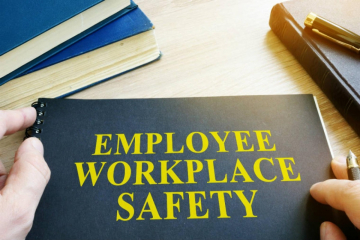Showing a commitment to environment, health, and safety (EHS) remains a priority for not just customers, but for investors, NGOs, and employees too.
As calls for transparency grow, companies need to have strong and effective EHS procedures in place and be ready to respond to questions that may come from internal and external parties. An EHS policy articulates a company’s commitment to EHS and lays out the guiding principles, expectations, and values around EHS. This makes it a powerful tool to rally the troops and spark dialogue around your company’s priorities and initiatives, but only when it is authentically grounded in the realities of your business and aligned with your company culture.
Let’s take a deeper dive into creating a strong and compelling EHS policy, customizing it for your company, and then communicating it to your target audience.
Creating Your EHS Policy
An EHS policy demonstrates leadership’s commitment to EHS and articulates key program concepts that are material to day-to-day business operations. It's a critical tool for educating internal and external stakeholders about the function, philosophy, and authority of EHS at the organization. Running an EHS program without a clear policy to back it up is like steering a ship with no rudder—EHS needs the leadership commitment and the implicit authority to act to create a meaningful and effective EHS program for the company.
EHS policies are different from company to company, and to be truly effective, a policy should both capture the EHS aspects that are important at your company and reflect your unique culture. To create a meaningful and compelling EHS policy for your company, leadership should consider the following:
- Purpose – Why is EHS important to us? Here is an opportunity to tie EHS into company values and business strategy. This could include protecting employees, reducing accidents, ensuring environmental protection, or maintaining compliance.
- Audience - Who will be reading the EHS policy? Will this only be shared internally or on your company's external website? Possible audiences include customers, suppliers, investors, employees, and the public.
- Scope and Content - What parts of the business are included? A single facility, multiple facilities, suppliers, surrounding environments? How detailed should the policy be? Again, be consistent with your company culture – are your company’s policies short and sweet? Or detailed and explicit?
- Signature – Who will sign the policy? Ideally, the policy is signed by the highest-level executive within the organization.
To get insights into the above, leaders can review results from past audits, materiality assessments, customer questionnaires, industry reports, and community feedback. It’s also crucial to make sure you have buy-in from all stakeholders before proceeding.
Customizing Your EHS Policy
Once you have the rough outline for the policy, you need to fill in the details. However, while EHS policies typically have similar high-level goals—to demonstrate leadership commitment and articulate EHS aspects important to the company—they aren’t one-size-fits-all. The trick is to create an EHS policy that is tailored to your company. Think of a tech company with low-risk offices as compared to a heavy manufacturing company—the EHS priorities and needs of each are very different, which should be reflected in their respective EHS policies.
Also, think about the tone of the policy and how you want to convey your message. Make sure the tone is consistent with your company culture. Review other company policies that have been successful or highly regarded and try to pattern your approach on theirs. (Helpful hint: if you need inspiration, try searching online for example policies from companies who have made theirs publicly available.)
From here, you can create an EHS policy that is fit-for-purpose and aligned with company values and culture.
Communicating Your EHS Policy
Now that you’ve got a great EHS policy in place, it’s time to share it. The launch of a new EHS policy is an ideal opportunity for company leadership to publicly communicate the policy and demonstrate leadership commitment to EHS.
Integrating the policy into written EHS programs, trainings, and company presentations is imperative. If the EHS policy is totally new (rather than an update of an existing policy), consider offering training refreshes or eLearning courses as part of your launch. On-going internal refresher communications, like EHS newsletters, printed copies of the policy at every office, or other types of information sharing are vital to keeping employees informed and engaged. To relate your EHS policy back to the real world, try including examples of incidents and success stories, office location maps, or quotes from employees. If you want to take things a step further, get interactive or visual tools like videos, infographics, or interactive websites to tell your EHS story.
Following the internal launch, brands with many external customers might choose to post the policy publicly for easy access, whereas smaller companies with fewer clients might choose to keep it more limited.
An EHS policy is the cornerstone of an effective EHS program for all companies. No matter which industry you’re in, a compelling and well-communicated EHS policy establishes a solid foundation for successful environment, health, and safety programs.
Antea Group experts have helped companies all over the world create and implement EHS policies that reflect their values, priorities, and needs. Contact us today to learn more.
Want more news and insights like this?
Sign up for our monthly e-newsletter, The New Leaf. Our goal is to keep you updated, educated, and even a bit entertained as it relates to all things EHS and sustainability.
Have any questions?
Contact us to discuss your environment, health, safety and sustainability needs today.







